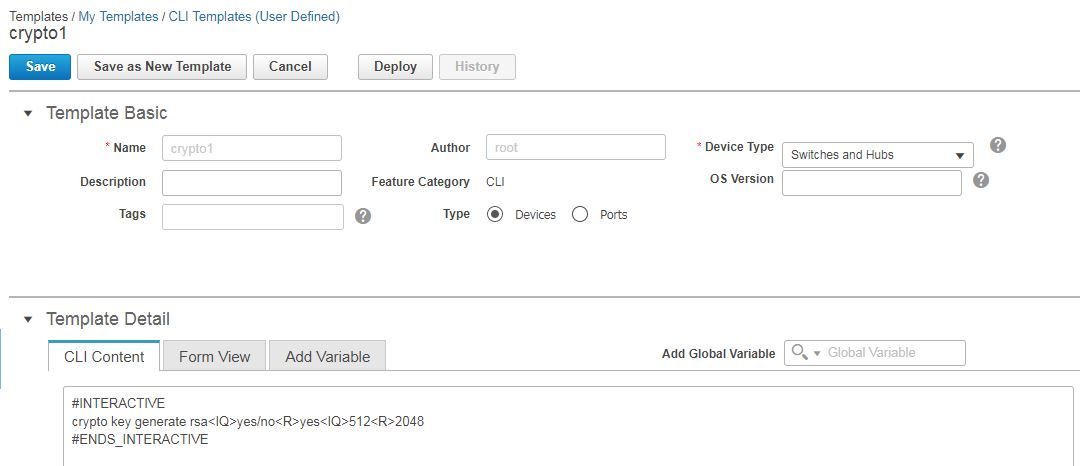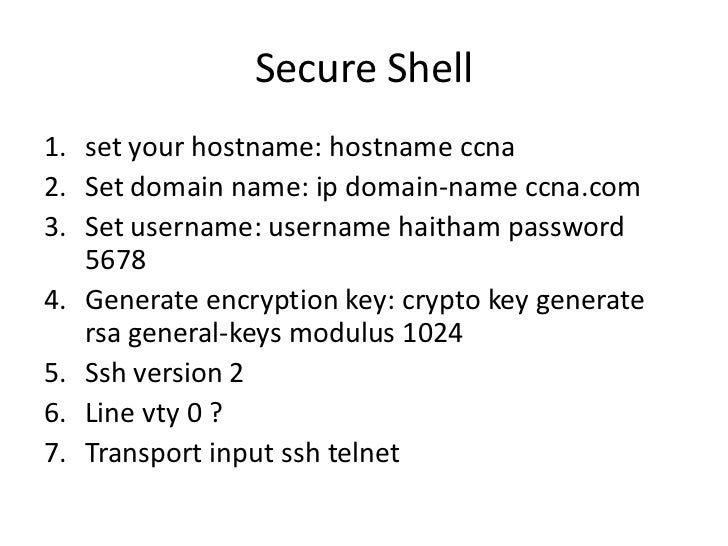Crypto Key Generate Rsa Command Meaning
Oct 02, 2015 SSH Config and crypto key generate RSA command. Use this command to generate RSA key pairs for your Cisco device (such as a router). Keys are generated in pairs–one public RSA key and one private RSA key. If your router already has RSA keys when you issue this command, you will be warned and prompted to replace the existing keys with new keys. Oct 25, 2019 Generate the key pair! Router(config)# crypto key generate rsa general-purpose label mycs exportable The name for the keys will be: mycs Choose the size of the key modulus in the range of 360 to 2048 for your General Purpose Keys. Choosing a key modulus greater than 512 may take a few minutes. Router(config)# crypto key generate rsa general-keys The name for the keys will be: myrouter.example.com Choose the size of the key modulus in the range of 360 to 2048 for your General Purpose Keys. Choosing a key modulus greater than 512 may take a few minutes. So it looks as if there is no point in the 'crypto key generate rsa' command if i follow it up with the 'crypto key generate rsa usage-keys label sshkeys mod 1024' command, i just wanted to make sure the first wasn't need for the second to work or something screwy like that. Aug 19, 2018 @miigotu 'youthinks' wrong. E should be chosen so that e and λ(n) are coprime. It is not chosen at random, and since it is usually small for computation reasons, and included in the public key, it can always be known by an attacker anyway. Yes the genrsa switch is the key that's getting generated in the req command. To generate the key I believe you just need to run this command: $ openssl genrsa -out clientkey.pem I always reference this page titled: The Most Common OpenSSL Commands - SSL Shopper.You can see from the examples that the key for a CSR is RSA, you can even control it's length when using the req command through the.
Generate Rsa Key Command
Privacy Overview
That changes the meaning of the command from that of exporting the public key to exporting the private key outside of its encrypted wrapper. Inspecting the output file, in this case privateunencrypted.pem clearly shows that the key is a RSA private key as it starts with -BEGIN RSA PRIVATE KEY-.

Necessary cookies are absolutely essential for the website to function properly. This category only includes cookies that ensures basic functionalities and security features of the website. These cookies do not store any personal information.
Any cookies that may not be particularly necessary for the website to function and is used specifically to collect user personal data via analytics, ads, other embedded contents are termed as non-necessary cookies. It is mandatory to procure user consent prior to running these cookies on your website.
-->
Creating and managing keys is an important part of the cryptographic process. Symmetric algorithms require the creation of a key and an initialization vector (IV). The key must be kept secret from anyone who should not decrypt your data. The IV does not have to be secret, but should be changed for each session. Asymmetric algorithms require the creation of a public key and a private key. The public key can be made public to anyone, while the private key must known only by the party who will decrypt the data encrypted with the public key. This section describes how to generate and manage keys for both symmetric and asymmetric algorithms.
Symmetric Keys
The symmetric encryption classes supplied by the .NET Framework require a key and a new initialization vector (IV) to encrypt and decrypt data. Whenever you create a new instance of one of the managed symmetric cryptographic classes using the parameterless constructor, a new key and IV are automatically created. Anyone that you allow to decrypt your data must possess the same key and IV and use the same algorithm. Generally, a new key and IV should be created for every session, and neither the key nor IV should be stored for use in a later session.
To communicate a symmetric key and IV to a remote party, you would usually encrypt the symmetric key by using asymmetric encryption. Sending the key across an insecure network without encrypting it is unsafe, because anyone who intercepts the key and IV can then decrypt your data. For more information about exchanging data by using encryption, see Creating a Cryptographic Scheme.
The following example shows the creation of a new instance of the TripleDESCryptoServiceProvider class that implements the TripleDES algorithm.
When the previous code is executed, a new key and IV are generated and placed in the Key and IV properties, respectively.
Sometimes you might need to generate multiple keys. In this situation, you can create a new instance of a class that implements a symmetric algorithm and then create a new key and IV by calling the GenerateKey and GenerateIV methods. /java-aes-256-key-generator.html. The following code example illustrates how to create new keys and IVs after a new instance of the symmetric cryptographic class has been made.
When the previous code is executed, a key and IV are generated when the new instance of TripleDESCryptoServiceProvider is made. Another key and IV are created when the GenerateKey and GenerateIV methods are called.
What Is The Purpose Of The Crypto Key Generate Rsa Command
Asymmetric Keys
The .NET Framework provides the RSACryptoServiceProvider and DSACryptoServiceProvider classes for asymmetric encryption. These classes create a public/private key pair when you use the parameterless constructor to create a new instance. Asymmetric keys can be either stored for use in multiple sessions or generated for one session only. While the public key can be made generally available, the private key should be closely guarded.
A public/private key pair is generated whenever a new instance of an asymmetric algorithm class is created. /movavi-18-activation-key-generator.html. After a new instance of the class is created, the key information can be extracted using one of two methods:
The ToXmlString method, which returns an XML representation of the key information.
The ExportParameters method, which returns an RSAParameters structure that holds the key information.
Both methods accept a Boolean value that indicates whether to return only the public key information or to return both the public-key and the private-key information. An RSACryptoServiceProvider class can be initialized to the value of an RSAParameters structure by using the ImportParameters method.
Asymmetric private keys should never be stored verbatim or in plain text on the local computer. If you need to store a private key, you should use a key container. For more on how to store a private key in a key container, see How to: Store Asymmetric Keys in a Key Container.
The following code example creates a new instance of the RSACryptoServiceProvider class, creating a public/private key pair, and saves the public key information to an RSAParameters structure.